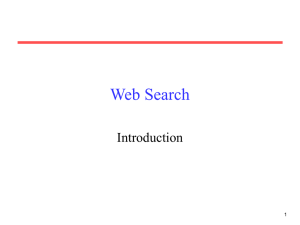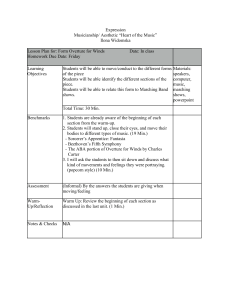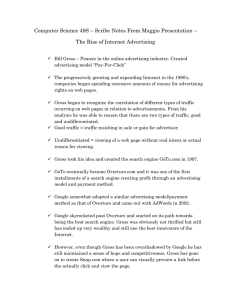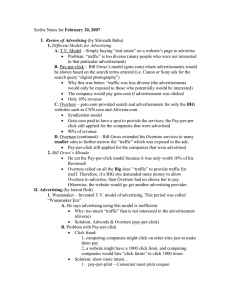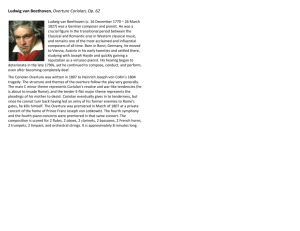Overture and Google: Internet Pay-Per
advertisement
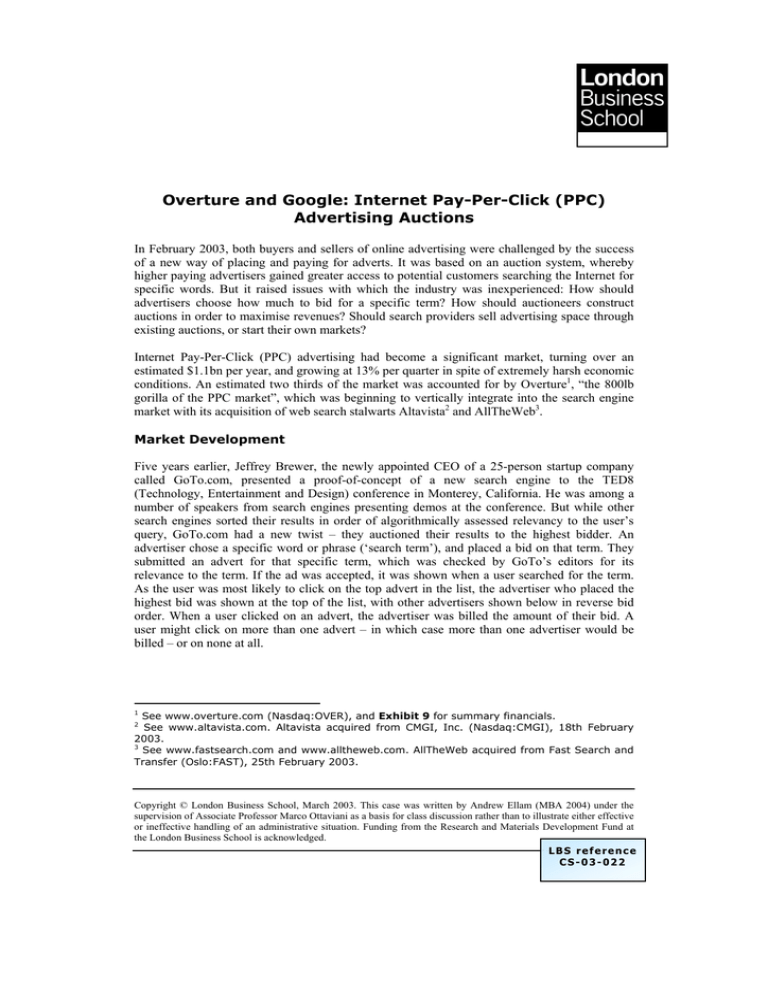
l Overture and Google: Internet Pay-Per-Click (PPC) Advertising Auctions In February 2003, both buyers and sellers of online advertising were challenged by the success of a new way of placing and paying for adverts. It was based on an auction system, whereby higher paying advertisers gained greater access to potential customers searching the Internet for specific words. But it raised issues with which the industry was inexperienced: How should advertisers choose how much to bid for a specific term? How should auctioneers construct auctions in order to maximise revenues? Should search providers sell advertising space through existing auctions, or start their own markets? Internet Pay-Per-Click (PPC) advertising had become a significant market, turning over an estimated $1.1bn per year, and growing at 13% per quarter in spite of extremely harsh economic conditions. An estimated two thirds of the market was accounted for by Overture1, “the 800lb gorilla of the PPC market”, which was beginning to vertically integrate into the search engine market with its acquisition of web search stalwarts Altavista2 and AllTheWeb3. Market Development Five years earlier, Jeffrey Brewer, the newly appointed CEO of a 25-person startup company called GoTo.com, presented a proof-of-concept of a new search engine to the TED8 (Technology, Entertainment and Design) conference in Monterey, California. He was among a number of speakers from search engines presenting demos at the conference. But while other search engines sorted their results in order of algorithmically assessed relevancy to the user’s query, GoTo.com had a new twist – they auctioned their results to the highest bidder. An advertiser chose a specific word or phrase (‘search term’), and placed a bid on that term. They submitted an advert for that specific term, which was checked by GoTo’s editors for its relevance to the term. If the ad was accepted, it was shown when a user searched for the term. As the user was most likely to click on the top advert in the list, the advertiser who placed the highest bid was shown at the top of the list, with other advertisers shown below in reverse bid order. When a user clicked on an advert, the advertiser was billed the amount of their bid. A user might click on more than one advert – in which case more than one advertiser would be billed – or on none at all. 1 See www.overture.com (Nasdaq:OVER), and Exhibit 9 for summary financials. See www.altavista.com. Altavista acquired from CMGI, Inc. (Nasdaq:CMGI), 18th February 2003. 3 See www.fastsearch.com and www.alltheweb.com. AllTheWeb acquired from Fast Search and Transfer (Oslo:FAST), 25th February 2003. 2 Copyright © London Business School, March 2003. This case was written by Andrew Ellam (MBA 2004) under the supervision of Associate Professor Marco Ottaviani as a basis for class discussion rather than to illustrate either effective or ineffective handling of an administrative situation. Funding from the Research and Materials Development Fund at the London Business School is acknowledged. LBS reference CS-03-022 Overture and Google: Internet Pay-Per-Click (PPC) Advertising Auctions Initially, GoTo marketed their new search engine to users on the virtue of its simplicity: “For us, 'search' is not a loss leader,” said Jeffrey Brewer, CEO of GoTo.com. “Search is what we're all about. While other search engines are adding complexity, we are stripping away all the clutter. We don't want to own your attention, like Yahoo! and AOL, keeping you locked up in their own content. We want to free you up to get to the best of the Internet. We don't do e-mail, we don't do chat, we don't do stock quotes. Our only goal is to get people to the web sites they are looking for in the fastest possible way.”4 With $6m of venture capital, GoTo began an advertising campaign to promote their site. With the slogan “search made simple”, they used radio advertising (60-second spots in major US cities, voiced by “shock jock” Howard Stern) and web banner adverts to generate traffic of 4m users per month by the end of 1998. A ‘banner’ was a rectangular graphical advert of a specific size, usually animated, which a website would place at the top of each page (‘run of site’) or on specific pages, for a fee (quoted on a cost per thousand, or ‘CPM’, basis). If the user clicked on the banner, they were taken to the advertiser’s website. The advertiser paid for each showing of the banner, whether or not the user clicked on it. GoTo’s use of banner advertising was unusually successful, with compelling messages: “Win a Howard Stern weekend in New York” (a competition to attend a recording of the Howard Stern Radio Show), and “Type in what you’re looking for” (which allowed a search query to be typed directly into the banner). However, click-through rates5 (‘CTR’) were falling for banner advertising in general, and falling faster than CPM rates, reducing the cost-effectiveness of banner adverts. Suggestions were emerging that users experienced “banner blindness”, whereby increasing familiarity with banners habituated users to identify them as adverts and avoid clicking on them (or perhaps even reading them). CTRs fell from above 5% in the early years of the web6 to below 0.5% by 2001 (though many experts contended that banner effectiveness should be assessed using measures such as increased brand recognition, as well as raw CTR). “Banner blindness” had a solid empirical basis, as users’ increased Internet experience was strongly correlated with low banner CTRs: Banner clickthrough rates in the different Internet experience groups7 6–12 1–3 Years 4–6 Years >6 Years User <6 Months Months Experience Experience Experience Experience Experience Experience Clickthrough 2.3% 0.6% 0.4% 0.3% 0.3% rate n = 5916, p < 0.01 This decline in the effectiveness of banner advertising, particularly for small advertisers with less powerful brands, made PPC increasingly attractive, and GoTo’s reach was increased when, in July 1999, it signed an agreement to provide search results for Netscape’s website. 4 GoTo.com press release, “GoTo.Com Makes Search Simple By Focusing Only On Search”, June 1st 1998. 5 Click-through-rate (CTR): The number of times an advertisement was clicked, as a percentage of the total number of times it was shown. 6 HotWired, the online division of Wired magazine, claims the credit for inventing the banner ad in October 1994. One of the first banners to be shown was for AT&T, and is rumoured to have achieved a 50% CTR. 7 Micael Dahlén, “Banner Advertisements through a New Lens”, Journal of Advertising Research, July/August 2001 2 Overture and Google: Internet Pay-Per-Click (PPC) Advertising Auctions Agreements with the other major ISPs8 and browser suppliers followed; these were particularly important for PPC search listings because many users were unable to change their home page from the default with which their browsers were shipped – which inevitably included a search box. The benefit for ISPs and other search providers was clear: they received a percentage of revenues GoTo derived from clicks on their sites. Competitors9 entered the PPC market with similar business models, and GoTo.com was rebranded as Overture, but retained a position of strong market leadership, with the bulk of its listings now being shown on other sites such as MSN, Yahoo! and AOL. Only a limited number of adverts, usually 4, were syndicated to the most important search destinations. Overture therefore referred to the top four places as ‘premium listings’, since they produced a much higher volume of clicks than lower rankings. Pay-per-click banner advertising models were introduced by competitors, as were ‘smart’ banners (which were, similarly to PPC search listings, shown when a user typed a particular search term). Neither of these, though, allowed advertisers the same degree of control over their campaigns as PPC search listings, nor was as appealing to smaller advertisers. Though advertisers and search engines argued that higher PPC search listing CTRs were due to the genuine relevance of adverts to their particular keywords, the US Federal Trade Commission warned the industry in mid-2002 that users were mistaking PPC adverts for unpaid, relevanceranked search listings (see Exhibit 1). Though PPC adverts were better distinguished from nonpaid listings following this warning, industry observers suspected a significant proportion of users remained unaware that the links they were clicking on were in fact adverts. Google Adwords Select In February 2002, Google introduced Adwords Select. This was a PPC programme with a number of key innovations: • Listings were ranked not only by bid amount, but also by CTR (see Exhibit 2). An advert with a high CTR could therefore gain a higher position than a competing advert with a higher bid, but a lower CTR. • Bidders did not pay the full amount of their bid; instead they paid one penny more than the bid below (or, if theirs was the lowest bid, they paid the minimum). This was called the ‘Adwords Select Discounter’ – it became known as ‘auto-bidding’. • Adverts could be targeted to any of a large number of countries, or to a particular language. • Adverts could be more closely targeted to particular search terms, using advanced keyword matching options (see Exhibit 3). Overture filed a lawsuit against Google, claiming infringement of its US Patent 6,269,361 (Exhibit 4), ‘System and method for influencing a position on a search result list generated by a computer network search engine’, which it claimed protected “various features and innovations relating to bid-for-placement products” – in effect Overture claimed it had US patent protection 8 9 Internet Service Providers Such as Espotting, Looksmart and FindWhat. 3 Overture and Google: Internet Pay-Per-Click (PPC) Advertising Auctions for PPC search engine advertising auctions. It was currently receiving licensing revenue from its competitor FindWhat following a lawsuit earlier in the year. FindWhat was challenging patent ‘361 in the US courts. Overture’s response also included the introduction of an auto-bidding system of its own. This worked in the same way as Google’s, except that it was optional (advertisers could still choose to place fixed bids), and the lowest bidder paid their bid (rather than paying the minimum). In the year following its introduction, Google Adwords Select proved highly attractive to advertisers, exceeding Overture’s other competitors in popularity. Some factors behind this success were Google’s added features over Overture; initially, its lower prices (due to a smaller number of bidders, and the use of auto-bidding); and its signup of AOL US as a search partner. PPC advertisers typically placed adverts with both Overture (to reach MSN and Yahoo! users) and Adwords (to reach AOL US users, and users of Google itself). Ask Jeeves showed results from both Overture and Adwords. Advertisers in European markets also used Espotting, which was well-represented in European search engines (see Exhibit 5). Bidding Mechanisms and Strategies Advertisers placed bids online, at the website of each PPC provider. When they placed a bid, an advertiser could see the current rank of their advert and, in the case of Overture, the bids placed by other advertisers (this information was not directly available at Google). Each bid remained valid until it was changed or removed. Typical bids ranged from $0.05 to $3.00, although some bids were placed as high as $40. The highest bids were on keywords related to property, class action lawsuits, or other ‘high-ticket’ items. The relationship between bid and ranking was typically non-linear, with the rate of increase in price increasing going up the page – see the graphs in Exhibit 6. Google provided advertisers with a tool to estimate, for a particular bid, the likely ranking and number of clicks per day they would achieve. This was necessarily inaccurate, as the exact ranking of an advert depended on its click-through rate, which could not be determined until it had been shown at least a few hundred times. Ad copy (the text of each advert) had a very significant effect on CTR – a well-written ad could have a CTR 5% higher than one which was poorly written. Estimated CTRs were also affected by the continuous changes in other advertiser’s bids, so would differ from one moment to the next. See Exhibit 7 for a sample dataset. There were also some indications that the estimation tool, while reasonably effective for search terms where adverts already existed, was particularly unreliable for search terms with no existing adverts (‘dead inventory’10). Each service had a minimum bid (a reserve price). Overture had consistently raised their minimum, from $0.02 to $0.10 over two years. Google provided a lower $0.0511 minimum in general, but enforced higher minimums of $0.10 to around $1.80 on specific keywords with high demand in particular countries. 10 Dead inventory was useful to advertisers because theirs could be the top – and only – advert shown, for the minimum bid. 11 While Google allowed bids to be placed in any currency for ads shown in any country, Overture only allowed advertisers to bid in the native currency of the country in which they wished to place their advert. This meant that Google minimums were equivalent for different countries, whereas Overture had a higher minimum for ads shown in the UK (£0.10) than those shown in the US ($0.10). The comparative ranking of Google adverts with bids placed in different currencies changed depending on exchange rates. 4 Overture and Google: Internet Pay-Per-Click (PPC) Advertising Auctions Users frequently mis-spelled their search queries. Overture automatically corrected some spelling errors and typos before displaying adverts, so ads would be displayed as if the user had typed their query correctly. Google did not do this, and advertisers placed profitable bids on misspellings. Some of the search partners belonging to each PPC provider showed the user a link suggesting a new search for the corrected spelling, while others did not. Overture’s editorial team checked all adverts for relevance before allowing them to go live, whereas Google placed adverts live on their own search engine immediately (unchecked) but checked them for relevance before syndicating them to their search partners. Google automatically disabled an advertiser’s bid if their CTR dropped below 0.5% for a particular keyword, which they claimed ensured a minimum level of relevance12. The ‘conversion rate’ of an advert was the proportion of users who, having arrived at the advertiser’s site, made a purchase. Different keyword phrases had different conversion rates. For example, any search containing the word “free” was significantly less likely to produce a conversion. This had an effect on bidding, because bids on different keyword groups affected each other. For example, adding the word “buy” to most keyword phrases made them more valuable, because it increased the probable conversion rate. If bidder A placed a bid on “real estate” and bidder B placed a higher bid on “buy real estate”, then bidder A would appear in their desired position for all searches involving “real estate”, except those for “buy real estate” – the more valuable search. Bidder A’s expected conversion rates would therefore not be likely to match their actual conversion rates – they would receive a disproportionate amount of the traffic no other bidders wanted. They would therefore likely be over-bidding. The conventional wisdom among advertisers was that a sensible bidding strategy was to calculate their conversion rate, then bid to maximise their ROI. Overture was particularly active in promoting this method of determining appropriate bid levels (see Exhibit 8). Google’s use of CTRs in determining ranking presented advertisers with a problem. A higher ranking produced a higher volume of clicks, but higher CTRs were often associated with lower conversion rates. For example, stating the price in an advert produced lower CTRs but higher conversion rates, as shoppers effectively pre-qualified themselves for the advertised product. Lower ranking was also associated with higher conversion rates: the further down the page an ad was located, the more likely a user who clicked on it was to be seriously considering purchase, rather than simply clicking on the first link which appeared. Some bidders placed very high bids in order to retain the top position on certain keyword phrases. Observers suspected that this produced an loss on each click, and were unsure whether bidders were using PPC for branding purposes, or were simply unaware of their losses. Auto-bidding allowed the use of a tactic known as a ‘competitor buster’, whereby a bidder placed their bid one cent below that of the competitor immediately above them. This allowed the original bidder’s costs to remain unchanged (since they paid one cent above the bid of the bidder 12 Poet Christophe Bruno, in April 2002, complained of ‘censorship’ from Google because the “non-sensical or funny or a bit provocative” poems he had placed as adverts were automatically deleted due to their low CTR. Though CTR for the campaign as a whole was below 0.5%, “Mary !!! / I love you / come back / john” received a surprising 1.1%. See www.iterature.com/adwords/ (contains offensive language used under poetic license). 5 Overture and Google: Internet Pay-Per-Click (PPC) Advertising Auctions immediately below), while increasing costs for their competitor. For example, if bidder A were to bid $20.00, bidder B $10.00 and bidder C $5.00, then bidder B could raise their bid to $19.99 to force bidder A to pay the full $20.00 while bidder B’s cost remained unchanged at $5.01. This tactic was dangerous, since if the competitor changed their bid to be one cent below that of the original bidder, the tables would be turned. When using this technique, it was therefore vital for a bidder to update their bid as often as possible, a task that was achieved using automated bidding programs such as Go Toast: Our new Competition Maximum Cap Rule (Bid Top Of Gap) has become extremely popular with those of you utilizing Overture. As a reminder, you can now place your Maximum Cap at just one cent below the Maximum Cap of the position above you. Your cost per click will continue to be one cent above the position below you. The Bid Top of Gap Rule discourages the competition below you from outbidding you and maximizes the cost to maintain the position above you.13 Content-Targeted PPC Both Overture and Google intended to move their PPC programmes beyond search, and begin showing PPC adverts on content sites. Overture expressed its intention to spend $12m on content-targeted PPC, and in February 2003 Google began its Content-Targeted Advertising program, showing Adwords ads on non-search partner sites. It also acquired the parent company, Pyra Labs, of one of its content-targeted PPC partners, Blogger. The page on which each ad was shown was intended to be relevant to the keywords for which the advertiser had placed their bid. BusinessWeek commented that: The move casts Mountain View, Calif.-based Google in a more prominent role as an advertising network, much like 24/7 Media, Avenue A or former adselling giant DoubleClick. These companies, flush with cash during the dotcom boom, have handled the ad sales efforts of thousands of Web operators for years, selling banners, buttons and links on sites relevant to an advertiser's products. As opposed to these companies, though, Google draws advertisers to its own site first and then sells links on partner sites. Many ad networks saw their fortunes fall with the dot-com bust, but as searchrelated advertising has emerged as a winner in recent years, it's helped to fuel a revival in the business. The focus Google and others have placed on selling sponsored text links has proved effective for advertisers, partners and Web surfers alike 14 Strategic Decisions Lacking a useful model for PPC bidding, a stream of naive bidders entered the PPC marketplace, placed absurdly high bids in order to gain top positions, exhausted their budgets and exited the market. Other, experienced bidders maintained successful strategies largely through trial and error, but were unable to assess how well their campaigns were fulfilling their potential. 13 Go Toast Newsletter, 31st July 2002, www.managebid.com/pdf/GTnewsletter07312002.asp. “Google's search for new ad revenue”, BusinessWeek Online, Sunday March 2nd, http://www.businessweek.com/technology/cnet/stories/990442.htm 14 6 Overture and Google: Internet Pay-Per-Click (PPC) Advertising Auctions PPC had come to dominate the monetization of Internet search. The remaining search providers faced a choice: they could either continue to syndicate PPC results from suppliers who were rapidly gaining market power, or they could develop (or acquire) their own PPC auction systems. No reference material or academic literature was available on PPC auctions. How could bidders and potential auctioneers begin to develop a rational model for this innovative market? 7 Overture and Google: Internet Pay-Per-Click (PPC) Advertising Auctions Exhibit 1: US Federal Trade Commission letter to search engines and PPC suppliers15 UNITED STATES OF AMERICA FEDERAL TRADE COMMISSION Bureau of Consumer Protection Division of Advertising Practices WASHINGTON, D.C. 20580 June 27, 2002 [search engine company address address] Re Commercial Alert Complaint Requesting Investigation of Various Internet Search Engine Companies for Paid Placement and Paid Inclusion Programs Dear [search engine company]: The Federal Trade Commission responded to a complaint filed by Commercial Alert requesting that the agency investigate whether certain search engines are violating Section 5 of the Federal Trade Commission Act ("FTC Act"), 15 U.S.C. § 45(a)(1),(1) by failing to disclose that advertisements are inserted into search engine results lists. Commercial Alert's complaint alleges that when search engines include Web sites in search results lists, on the basis of "paid placement" and "paid inclusion," such search results are advertisements. It further contends that "without clear and conspicuous disclosure that the ads are ads," such "concealment may mislead search engine users to believe that search results are based on relevancy alone, not marketing ploys." The FTC's Bureau of Consumer Protection staff reviewed the search engines listed in the Commercial Alert complaint and others. For the most part, the staff believes that while many search engine companies do attempt some disclosure of paid placement, their current disclosures may not be sufficiently clear. The staff also believes that, depending on the nature of the paid inclusion program, there should be clearer disclosure of the use of paid inclusion, including more conspicuous descriptions of paid inclusion itself.(2) As a general matter, clear and conspicuous disclosures would put consumers in a position to better determine the importance of these practices in their choice of search engines to use. Indeed, a recent Consumers Union national survey found that 60% of Internet users had no idea that certain search engines were paid fees to list some sites more prominently than others in their search results. After being told that some search engines take these fees, 80% said it is important (including 44% who said it is very important) for a search engine to disclose, in its search results or in an easy-to-find page on its site, that it is being paid to list certain sites more prominently.(3) Accordingly, the staff recommends that if your search engine uses paid placement, you make any changes to the presentation of your paid-ranking search results that would be necessary to clearly delineate them as such, whether they are segregated from, or inserted into, non-paid listings. Factors to be considered in making such a disclosure clear and conspicuous are prominence, placement, presentation (i.e., it uses terms and a format that are easy for consumers to understand, and that do not contradict other statements made), and proximity to a claim that it explains or qualifies. 15 http://www.ftc.gov/os/closings/staff/commercialalertattatch.htm 8 Overture and Google: Internet Pay-Per-Click (PPC) Advertising Auctions Moreover, the staff recommends that if your search engine uses paid inclusion programs that may distort rankings or placement criteria, you clearly describe how sites are selected for inclusion in your indices.(4) Also, consumers should be able to easily locate your explanation of the paid inclusion program you use, and discern the impact of paid inclusion in search results lists. Finally, the staff recommends that you review your Web sites to ensure that: • • • any paid ranking search results are distinguished from non-paid results with clear and conspicuous disclosures; the use of paid inclusion is clearly and conspicuously explained and disclosed; and no affirmative statement is made that might mislead consumers as to the basis on which a search result is generated. To the extent that your company provides search results to third-party Web sites, including other search engines or guides, we recommend that you discuss with the third-party Web sites whether the above criteria are being met with respect to any search results provided that involve a payment of any kind for ranking, insertion of paid results into unpaid results, or any pay-for-inclusion requirements. The staff recognizes that search engine companies' business models vary and that there is a need for flexibility in the manner in which paid placement and paid inclusion are clearly and conspicuously disclosed. We encourage you to review and implement the guidance provided in the Commission's business education piece, Dot Com Disclosures: Information About Online Advertising, which discusses how to make clear and conspicuous disclosures online.(5) Finally, although the staff of the Bureau of Consumer Protection has determined not to recommend that the Commission take formal action with respect to the Commercial Alert complaint, that determination should not be construed as a determination by either the Bureau of Consumer Protection or the Commission as to whether or not the practices described in the complaint violate the FTC Act or any other statute enforced by the Commission. Please contact Beverly Thomas or Dean Forbes at 202-326-2938 or 202-326-2831 with any questions you may have about the guidance provided in this letter. Very truly yours, Heather Hippsley Acting Associate Director Division of Advertising Practices Endnotes: 1. Section 5 of the FTC Act prohibits unfair or deceptive acts or practices in or affecting commerce. The Commission will find deception if there is a representation, omission, or practice that is likely to mislead the consumer acting reasonably in the circumstances, to the consumer's detriment. See FTC Policy Statement on Deception, appended to Cliffdale Associates, Inc., 103 F.T.C. 110, 174 (1984). 2. Examples of paid inclusion are programs under which companies can pay to have their Web sites or URLs reviewed more quickly, or for more frequent spidering of their Web sites or URLs, or for the review or inclusion of deeper levels of their Web sites than would otherwise be the case. 3. See "A Matter of Trust: What Users Want From Web Sites," www.consumerwebwatch.com/news/report1.pdf (Apr. 16, 2002). 4. Of course, if all Web sites included in a search guide or a search engine's database have paid to be included, so that the search engine is essentially an advertising medium, that fact should be adequately disclosed. 5. Dot Com Disclosures: Information About Online Advertising is available on the FTC Web site at www.ftc.gov/bcp/conline/pubs/buspubs/dotcom/index.pdf. 9 Overture and Google: Internet Pay-Per-Click (PPC) Advertising Auctions Exhibit 2: Google Adwords Programme Overview16 16 https://adwords.google.co.uk/select/overview.html 10 Overture and Google: Internet Pay-Per-Click (PPC) Advertising Auctions Exhibit 3: Google Adwords Keyword Matching Options17 Try keyword matching options to narrow your searches. With keyword matching options, you can refine your searches even further by specifying whether you want your ad to appear only for certain searches on your keywords. Examples: 17 • Broad match. Simply enter your keyword: tennis shoes Ad shows when users search on the keywords tennis and shoes, regardless of other search terms used or of the order in which they are entered. • Exact match. Use brackets around your keyword: [tennis shoes] Ad shows when users search only on the phrase tennis shoes. Ad will not show if red tennis shoes is searched. • Phrase match. Use quotes around your keyword: "tennis shoes" Ad shows when the phrase tennis shoes is searched, but search can contain other terms. Ad will show for red tennis shoes but not for shoes for tennis. • Negative keyword. Use a dash before your keyword: -red If your keyword is tennis shoes and your negative keyword is -red, your ad will not show if a user searches on red tennis shoes. https://adwords.google.co.uk/select/faq/keywords.html 11 Overture and Google: Internet Pay-Per-Click (PPC) Advertising Auctions Exhibit 4: US Patent 6,269,361 (cover page) 12 Overture and Google: Internet Pay-Per-Click (PPC) Advertising Auctions Exhibit 5: PPC suppliers for major search engines, February 2003 Search Engine PPC Supplier AllTheWeb (FAST) Altavista AOL AskJeeves BTLookSmart Google Hotbot IWon LookSmart Lycos MSN search.netscape.com netscape.com Overture Teoma WiseNut Yahoo Voila.fr T-online.de Virgilio.it Fireball.de Nomade.fr Club-internet.fr Altavista.it Yahoo.it Lycos.it Supereva.it Yahoo.es Altavista.es AOL.uk Overture Overture Google Adwords Overture / Google Adwords Espotting / BTLookSmart Google Adwords Overture / FindWhat Overture LookSmart Overture Overture Google Adwords Google Adwords / Overture / LookSmart Overture Overture LookSmart Overture Voila / Overture Overture Virgilio.it Espotting Overture Overture Espotting Espotting Overture / Espotting Godado Espotting Espotting Overture 13 Overture and Google: Internet Pay-Per-Click (PPC) Advertising Auctions Exhibit 6: Overture and Google prices Rank (1 is highest) Broad match on 'Real Estate', US all languages, 2nd March 2003 10:20 - 10:27 am 20 Overture CPC 18 Google Max CPC 16 Google Average CPC 14 12 10 8 6 4 2 0 $- $1.00 $2.00 $3.00 $4.00 $5.00 $6.00 Price Google exact match on [real estate], US all languages, 2nd March 2003 10:38 - 10:45 am Google Max CPC 8 Google Average CPC 7 Rank (1 is highest) 6 5 4 3 2 1 0 $- $0.20 $0.40 $0.60 $0.80 Price 14 $1.00 $1.20 $1.40 Overture and Google: Internet Pay-Per-Click (PPC) Advertising Auctions Exhibit 7: Google price / rank / click-volume relationships Estimated clicks / day Google exact match on [real estate], US all languages, 2nd March 2003 10:50 - 11:00 am 300 250 200 150 100 50 0 0 1 2 3 4 5 Estimated rank (1 is highest) Estimated clicks / day Google exact match on [real estate], US all languages, 2nd March 2003 10:50 - 11:00 am 300 250 200 150 100 50 0 $0.00 $0.50 $1.00 $1.50 Estimated average C PC Estimated rank (1 is highest) Google exact match on [real estate], US all languages, 2nd March 2003 10:50 - 11:00 am 5 4 3 2 1 0 $0.00 $0.50 $1.00 Estimated average C PC 15 $1.50 Overture and Google: Internet Pay-Per-Click (PPC) Advertising Auctions Exhibit 8: Overture ROI Calculator18 18 http://www.overture.com/d/USm/learning/roic.jhtml 16 Overture and Google: Internet Pay-Per-Click (PPC) Advertising Auctions Exhibit 9: Overture Summary Financials19 Summary Financials Quarter ended September 30, 2002 Quarter ended June 30, 2002 Year ended December 31, 2001 Revenue $172.7 million $152.5 million $288.1 million Net Income1 $16.9 million / $0.28 EPS $17.5 million / $0.29 EPS $20.2 million / $0.36 EPS EBITDA $29.8 million $32.3 million $32.4 million Total Assets $369.7 million $332.5 million $231.9 million Cash / Liquid Investments2 $221 million $200 million $170 million Debt $0 $0 < $0.1 million DSO 13 days 14 days 11 days 1 Second quarter 2002 results included a tax provision of $10.4 million while the first quarter 2002 had no tax expense. 2 Cash equivalents and short-term and long-term investments, excluding restricted investments. 19 http://www.overture.com/d/USm/about/news/fing.jhtml 17
